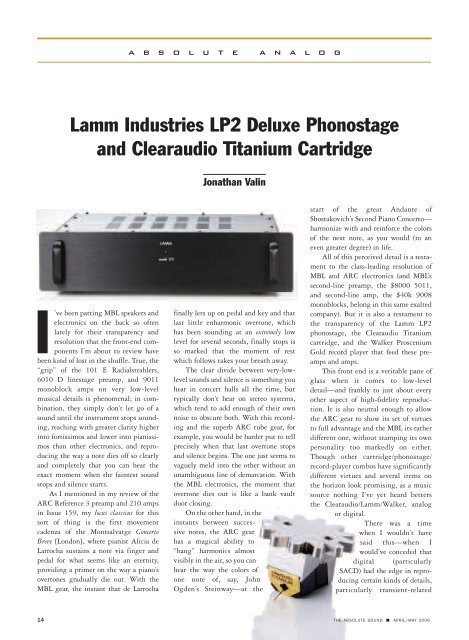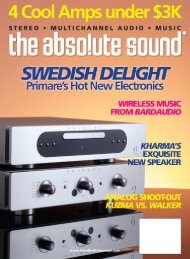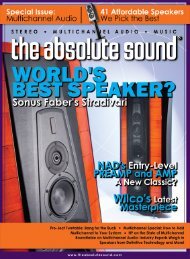in this issue
in this issue
in this issue
Create successful ePaper yourself
Turn your PDF publications into a flip-book with our unique Google optimized e-Paper software.
a b s o l u t e a n a l o g<br />
Lamm Industries LP2 Deluxe Phonostage<br />
and Clearaudio Titanium Cartridge<br />
Jonathan Val<strong>in</strong><br />
I’ve been patt<strong>in</strong>g MBL speakers and<br />
electronics on the back so often<br />
lately for their transparency and<br />
resolution that the front-end components<br />
I’m about to review have<br />
been k<strong>in</strong>d of lost <strong>in</strong> the shuffle. True, the<br />
“grip” of the 101 E Radialstrahlers,<br />
6010 D l<strong>in</strong>estage preamp, and 9011<br />
monoblock amps on very low-level<br />
musical details is phenomenal; <strong>in</strong> comb<strong>in</strong>ation,<br />
they simply don’t let go of a<br />
sound until the <strong>in</strong>strument stops sound<strong>in</strong>g,<br />
reach<strong>in</strong>g with greater clarity higher<br />
<strong>in</strong>to fortissimos and lower <strong>in</strong>to pianissimos<br />
than other electronics, and reproduc<strong>in</strong>g<br />
the way a note dies off so clearly<br />
and completely that you can hear the<br />
exact moment when the fa<strong>in</strong>test sound<br />
stops and silence starts.<br />
As I mentioned <strong>in</strong> my review of the<br />
ARC Reference 3 preamp and 210 amps<br />
<strong>in</strong> Issue 159, my locus classicus for <strong>this</strong><br />
sort of th<strong>in</strong>g is the first movement<br />
cadenza of the Montsalvatge Concerto<br />
Breve [London], where pianist Alicia de<br />
Larrocha susta<strong>in</strong>s a note via f<strong>in</strong>ger and<br />
pedal for what seems like an eternity,<br />
provid<strong>in</strong>g a primer on the way a piano’s<br />
overtones gradually die out. With the<br />
MBL gear, the <strong>in</strong>stant that de Larrocha<br />
f<strong>in</strong>ally lets up on pedal and key and that<br />
last little enharmonic overtone, which<br />
has been sound<strong>in</strong>g at an extremely low<br />
level for several seconds, f<strong>in</strong>ally stops is<br />
so marked that the moment of rest<br />
which follows takes your breath away.<br />
The clear divide between very-lowlevel<br />
sounds and silence is someth<strong>in</strong>g you<br />
hear <strong>in</strong> concert halls all the time, but<br />
typically don’t hear on stereo systems,<br />
which tend to add enough of their own<br />
noise to obscure both. With <strong>this</strong> record<strong>in</strong>g<br />
and the superb ARC tube gear, for<br />
example, you would be harder put to tell<br />
precisely when that last overtone stops<br />
and silence beg<strong>in</strong>s. The one just seems to<br />
vaguely meld <strong>in</strong>to the other without an<br />
unambiguous l<strong>in</strong>e of demarcation. With<br />
the MBL electronics, the moment that<br />
overtone dies out is like a bank vault<br />
door clos<strong>in</strong>g.<br />
On the other hand, <strong>in</strong> the<br />
<strong>in</strong>stants between successive<br />
notes, the ARC gear<br />
has a magical ability to<br />
“hang” harmonics almost<br />
visibly <strong>in</strong> the air, so you can<br />
hear the way the colors of<br />
one note of, say, John<br />
Ogden’s Ste<strong>in</strong>way—at the<br />
start of the great Andante of<br />
Shostakovich’s Second Piano Concerto—<br />
harmonize with and re<strong>in</strong>force the colors<br />
of the next note, as you would (to an<br />
even greater degree) <strong>in</strong> life.<br />
All of <strong>this</strong> perceived detail is a testament<br />
to the class-lead<strong>in</strong>g resolution of<br />
MBL and ARC electronics (and MBL’s<br />
second-l<strong>in</strong>e preamp, the $8000 5011,<br />
and second-l<strong>in</strong>e amp, the $40k 9008<br />
monoblocks, belong <strong>in</strong> <strong>this</strong> same exalted<br />
company). But it is also a testament to<br />
the transparency of the Lamm LP2<br />
phonostage, the Clearaudio Titanium<br />
cartridge, and the Walker Proscenium<br />
Gold record player that feed these preamps<br />
and amps.<br />
This front end is a veritable pane of<br />
glass when it comes to low-level<br />
detail—and frankly to just about every<br />
other aspect of high-fidelity reproduction.<br />
It is also neutral enough to allow<br />
the ARC gear to show its set of virtues<br />
to full advantage and the MBL its rather<br />
different one, without stamp<strong>in</strong>g its own<br />
personality too markedly on either.<br />
Though other cartridge/phonostage/<br />
record-player combos have significantly<br />
different virtues and several items on<br />
the horizon look promis<strong>in</strong>g, as a music<br />
source noth<strong>in</strong>g I’ve yet heard betters<br />
the Clearaudio/Lamm/Walker, analog<br />
or digital.<br />
There was a time<br />
when I wouldn’t have<br />
said <strong>this</strong>—when I<br />
would’ve conceded that<br />
digital (particularly<br />
SACD) had the edge <strong>in</strong> reproduc<strong>in</strong>g<br />
certa<strong>in</strong> k<strong>in</strong>ds of details,<br />
particularly transient-related<br />
14 THE ABSOLUTE SOUND ■ APRIL/MAY 2006










